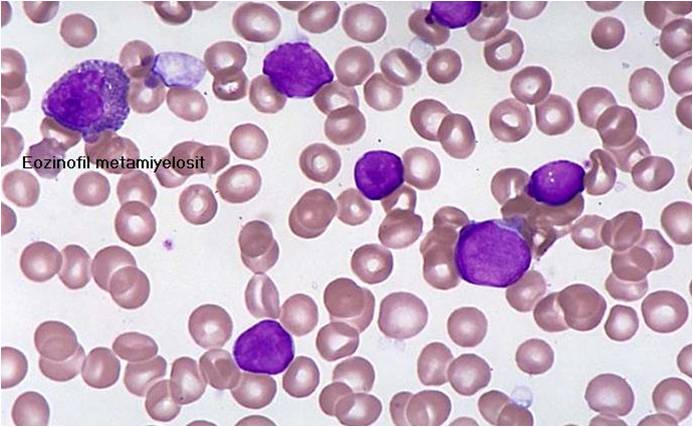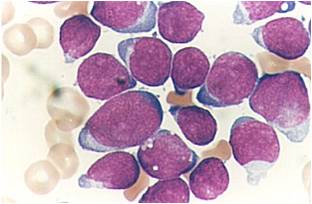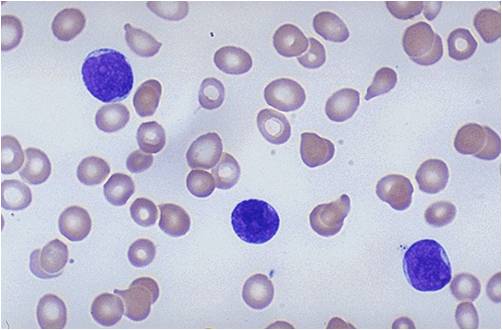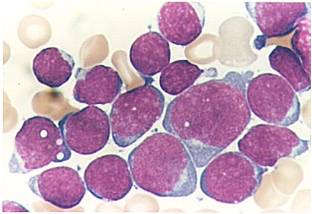Acute lymphoblastic leukemia classification
|
Acute lymphoblastic leukemia Microchapters |
|
Differentiating Acute lymphoblastic leukemia from other Diseases |
|---|
|
Diagnosis |
|
Treatment |
|
Case Studies |
|
Acute lymphoblastic leukemia classification On the Web |
|
American Roentgen Ray Society Images of Acute lymphoblastic leukemia classification |
|
Directions to Hospitals Treating Acute lymphoblastic leukemia |
|
Risk calculators and risk factors for Acute lymphoblastic leukemia classification |
Editor-In-Chief: C. Michael Gibson, M.S., M.D. [1] Associate Editor(s)-in-Chief: Raviteja Guddeti, M.B.B.S. [2] Carlos A Lopez, M.D. [3]
Overview
Acute lymphoblastic leukemia may be classified according to either the French-American-British (FAB) classification or World Health Organization (WHO) classification scheme. According to the French-American-British (FAB) classification, acute lymphoblastic leukemia may be classified into 3 subgroups: ALL-L1 (small uniform cells), ALL-L2 (large varied cells) and ALL-L3 (large varied cells with vacuoles). According to the World Health Organization (WHO), acute lymphoblastic leukemia may also be classified into 3 subgroups: B lymphoblastic leukemia/lymphoma, B lymphoblastic leukemia/lymphoma (not organ specific), and B lymphoblastic leukemia/lymphoma with recurrent genetic abnormalities.
Classification
Acute lymphoblastic leukemia may be classified according to either the French-American-British (FAB) classification system or the World Health Organization (WHO) classification system:
French-American-British Classification System
According to the French-American-British classification system, acute lymphoblastic leukemia is classified into 3 subgroups based on the cellular origin of the disease, cellular maturity, and morphology:[1][2]
- ALL-L1: small uniform cells
- ALL-L2: large varied cells
- ALL-L3: large varied cells with vacuoles (bubble-like features)
Each subtype is further classified based on immunophenotyping (the presence of surface markers of the abnormal lymphocytes). There are 2 main immunologic types:
The mature B-cell acute lymphoblastic leukemia (L3) is called Burkitt leukemia/lymphoma.
World Health Organization Classification System
The World Health Organization (WHO) classification of acute lymphoblastic leukemia is based on the prognosis of the disease. According to the WHO classification system, acute lymphoblastic leukemia may be classified into 3 subgroups:[5][6][7]
Group 1
- B lymphoblastic leukemia/lymphoma
Group 2
- B lymphoblastic leukemia/lymphoma (Not organ specific)
Group 3
- B lymphoblastic leukemia/lymphoma with recurrent genetic abnormalities:
- B lymphoblastic leukemia/lymphoma with t(9;22)(q34;q11.2), BCR-ABL1
- B lymphoblastic leukemia/lymphoma with t(v;11q23); MLL rearranged
- B lymphoblastic leukemia/lymphoma with t(12;21)(p13;q22) TEL-AML1 (ETV6-RUNX1)
- B lymphoblastic leukemia/lymphoma with hyperdiploidy
- B lymphoblastic leukemia/lymphoma with hypodiploidy
- B lymphoblastic leukemia/lymphoma with t(5;14)(q31;q32) IL3-IGH
- B lymphoblastic leukemia/lymphoma with t(1;19)(q23;p13.3) TCF3-PBX1
References
- ↑ van Eys J, Pullen J, Head D, Boyett J, Crist W, Falletta J, Humphrey GB, Jackson J, Riccardi V, Brock B (March 1986). "The French-American-British (FAB) classification of leukemia. The Pediatric Oncology Group experience with lymphocytic leukemia". Cancer. 57 (5): 1046–51. PMID 3484662.
- ↑ Lilleyman JS, Hann IM, Stevens RF, Eden OB, Richards SM (September 1986). "French American British (FAB) morphological classification of childhood lymphoblastic leukaemia and its clinical importance". J. Clin. Pathol. 39 (9): 998–1002. PMC 500200. PMID 3463568.
- ↑ Nahar R, Müschen M (2009). "Pre-B cell receptor signaling in acute lymphoblastic leukemia". Cell Cycle. 8 (23): 3874–7. doi:10.4161/cc.8.23.10035. PMC 4047560. PMID 19901533.
- ↑ Han X, Bueso-Ramos CE (2007). "Precursor T-cell acute lymphoblastic leukemia/lymphoblastic lymphoma and acute biphenotypic leukemias". Am J Clin Pathol. 127 (4): 528–44. doi:10.1309/2QE3A6EKQ8UYDYRC. PMID 17369128.
- ↑ Campo E, Swerdlow SH, Harris NL, Pileri S, Stein H, Jaffe ES (2011). "The 2008 WHO classification of lymphoid neoplasms and beyond: evolving concepts and practical applications". Blood. 117 (19): 5019–32. doi:10.1182/blood-2011-01-293050. PMC 3109529. PMID 21300984.
- ↑ Chiaretti S, Zini G, Bassan R (2014). "Diagnosis and subclassification of acute lymphoblastic leukemia". Mediterr J Hematol Infect Dis. 6 (1): e2014073. doi:10.4084/MJHID.2014.073. PMC 4235437. PMID 25408859.
- ↑ Kebriaei P, Anastasi J, Larson RA (December 2002). "Acute lymphoblastic leukaemia: diagnosis and classification". Best Pract Res Clin Haematol. 15 (4): 597–621. PMID 12617866.





